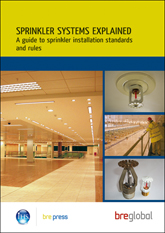Sprinkler systems explained: A guide to sprinkler installation standards and rules
BRE is an independent, research-based consultancy, testing and training organisation, operating in the built environment and associated industries. Its activities include; consultancy, research and innovation, testing, certification, approvals, training, events and accreditation.
On 17 June 2009, BRE published Sprinkler systems explained: A guide to sprinkler installation standards and rules.
Sprinkler systems distribute water to sprinklers which spray water into spaces, providing active fire protection. They are a well-established technology and have demonstrated their reliability and effectiveness in protecting life and property. Traditionally they have mainly been used in commercial and industrial properties, but they are now available for a wide range of applications, including domestic buildings.
They are designed and installed:
- To meet building control or other statutory requirements.
- To meet insurers’ requirements.
- To meet the risk management requirements of a business or property.
Sprinkler systems can be:
- Wet installations.
- Alternate wet and dry installations.
- Dry installations.
- Tail-end alternate systems.
- Pre-action installations.
- Deluge installations.
- System zones.
Sprinklers themselves can be:
- Conventional and spray type sprinklers.
- Ceiling, recessed and concealed type sprinklers.
- Side wall type sprinklers.
- Early Suppression Fast Response (ESFR) sprinklers.
- Enhanced Protection Extended Coverage (EPEC) sprinklers.
The standards for designing and installing sprinkler systems are sometimes seen as excessive and inflexible, but the history of real fire events on which the standards have been based should not be ignored.
BRE's 48 page report provides an aid to understanding fire sprinkler installations and the Loss Prevention Council's (LPCs) Rules to which they are designed. It explains the engineering behind the rules and regulations and some common misunderstandings about sprinkler systems.
The contents of the report include:
- Foreword.
- Introduction.
- How a sprinkler system works and what it is expected to do.
- Why sprinklers are installed.
- Extent of sprinkler protection.
- Hazard classification.
- Special classes of sprinkler system.
- Types of sprinkler system and controls installations.
- Water supplies.
- Sprinkler types.
- Pipework arrangements.
- Interaction with detection and alarm systems.
- Other design standards.
- Installers and installation.
- Service and maintenance.
- Changes of use.
- Approvals.
- References.
- Watermist systems for fire protection in domestic and residential buildings DG 534.
See also: Automatic fire sprinkler systems: A good practice guide.
[edit] Related articles on Designing Buildings Wiki
- Automatic fire sprinkler systems: A good practice guide
- BRE articles on Designing Buildings Wiki.
- Case study A for offices to show where automatic sprinklers have the greatest impact.
- Clean agent.
- Costs of water automatic sprinkler systems.
- Design benefits of automatic sprinkler systems granted under approved document B.
- Embedded security: Procuring an effective facility protective security system.
- Fire detection and alarm systems.
- Fire performance of external thermal insulation for walls of multistorey buildings, third edition (BR 135).
- Fire suppression.
- Leading built environment bodies call for sprinklers in all schools.
- Making the case for sprinklers and dispelling myths.
- Overview of automatic sprinkler system design and operation.
- Sprinkler.
- The cost efficiency of different combinations of fire protection measures.
- The impact of automatic sprinklers on building design.
Featured articles and news
RTPI leader to become new CIOB Chief Executive Officer
Dr Victoria Hills MRTPI, FICE to take over after Caroline Gumble’s departure.
Social and affordable housing, a long term plan for delivery
The “Delivering a Decade of Renewal for Social and Affordable Housing” strategy sets out future path.
A change to adoptive architecture
Effects of global weather warming on architectural detailing, material choice and human interaction.
The proposed publicly owned and backed subsidiary of Homes England, to facilitate new homes.
How big is the problem and what can we do to mitigate the effects?
Overheating guidance and tools for building designers
A number of cool guides to help with the heat.
The UK's Modern Industrial Strategy: A 10 year plan
Previous consultation criticism, current key elements and general support with some persisting reservations.
Building Safety Regulator reforms
New roles, new staff and a new fast track service pave the way for a single construction regulator.
Architectural Technologist CPDs and Communications
CIAT CPD… and how you can do it!
Cooling centres and cool spaces
Managing extreme heat in cities by directing the public to places for heat stress relief and water sources.
Winter gardens: A brief history and warm variations
Extending the season with glass in different forms and terms.
Restoring Great Yarmouth's Winter Gardens
Transforming one of the least sustainable constructions imaginable.
Construction Skills Mission Board launch sector drive
Newly formed government and industry collaboration set strategy for recruiting an additional 100,000 construction workers a year.
New Architects Code comes into effect in September 2025
ARB Architects Code of Conduct and Practice available with ongoing consultation regarding guidance.
Welsh Skills Body (Medr) launches ambitious plan
The new skills body brings together funding and regulation of tertiary education and research for the devolved nation.
Paul Gandy FCIOB announced as next CIOB President
Former Tilbury Douglas CEO takes helm.
UK Infrastructure: A 10 Year Strategy. In brief with reactions
With the National Infrastructure and Service Transformation Authority (NISTA).
























